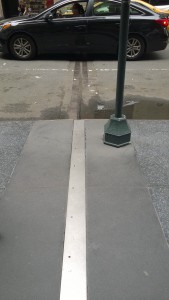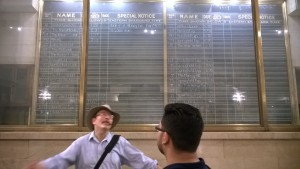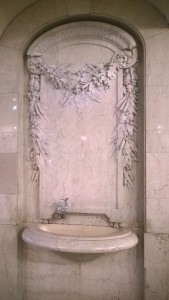LearningPlacesSiteReport GCT OpenLLearningPlacesSiteReport GCT OpenLab Citedab Cited
Author Archives: Frances
Site Report #2 NYPL The Schwarzman Building
Site Report Grand Central Terminal
William J. Wilgus Papers
This is a very interesting site made easy for whoever wants to conduct thorough research and is looking for primary sources. The first thing provided is organized citation information that can be cumbersome for those who either do not know how to do a citation or are just not willing to do the work to gather the info needed in order to do it properly. The collection overview is a summary of all its contents and the order in which they are organized making it easy for the researcher to find what they are looking for. Some of the materials are organized in chronological order and/or files labeled under projects names. It also provides keywords that may be used when trying to find this specific information. It is shock full of information categorized as primary sources since it contains correspondence from significant events, minutes of meetings conducted, reports, charts, statistics, etc., the list goes on and on proving itself to be a reliable resource with a wealth of information for the researcher.
The Bowery Boys Podcast
I kind of enjoyed hearing this podcast. Conducted as a talk news show keeps the listener interested. Although it is informative, most of the information was not new to me since reading Wikipedia and the official tours we were given provided most of the information heard on the podcast. However, the podcast had enlightened me with information that is new for me such as New York state giving Cornelius Vanderbilt and, his partner at the time, Burt Fulton a legalized monopoly to run ferry operations. Although the podcast was not done chronologically it is informative. I loved the fact that the podcast mentions Cornelius Vanderbilt’s current decedents CNN’s Anderson Cooper, and Gloria Vanderbilt who was known for her designer jeans that was popular during the late 1970s and early 1980s. The Bowery Boys also mentioned a quote made by William Wilgus, “taking wealth from the air” where real estate derived the concept “air rights.”
Analytical Summary–The New Terminal Of The “Grand Central”
The New York Times published an article on September 12, 1909 entitled ‘THE NEW TERMINAL OF THE “GRAND CENTRAL”’ that gives complete details of reconstruction of Grand Central all while not interrupting train services and the challenges it faced while doing so. It gives details of future plans in building “a city above a city,” restoring streets putting into effect air rights and an estimated value of property in the size “of a single railroad car”. Also included in the article are details of the four different levels within Grand Central and their purposes.
The themes discussed in class are as follows:
• Transportation / Culture of Travel
• Architectural Transition
• Engineering Changes / Tech Development
• Building Designs
• Culture
• Aesthetics Changes
I listed all of them because they all play a part in this particular article. Transportation / culture of travel is mentioned in the article pointing out the amount of people traveling and how they rely on Grand Central for this accomplishment both in time and destination. The architectural transition is described in details and gives images of its final outcome to the date (it is not as what it looks like today). Engineering and tech development are compared to a game of chess and as stated in the article, not a game of opposition but of collaboration. Culture also played an important role in this article because the privileged were used to traveling in high class depending on the Pullman’s luxury cars. The building designs are shown in drawn images. The aesthetic changes are described in words and points out the importance of the artistic designs.
Unknown. (1909, September 12). The New Terminal of the “Grand Central”. New York Times, p. SM9. Retrieved from http://search.proquest.com/docview/96947331?accountid=28313
Visit to Transit Museum and Archives
The visit to the Transit Museum and its archives has been an enlightening one. Curious questions thought throughout the years were answered in visiting this site such as how were tunnels built under the river for trains to go through? The answer is found in the following image… I use this image freely because according to the person in archives, we are allowed to use images taken from the Transit Museum since most images were taken before 1923 are considered to be public domain.
I use this image freely because according to the person in archives, we are allowed to use images taken from the Transit Museum since most images were taken before 1923 are considered to be public domain.
Since I arrived about 2 1/2 hours before my scheduled time for the archives, I took my time in looking at photos and reading tags. The story of building tunnels for the “future” electric trains involved many elements that affected history including those of labor laws and the creation of unions.
This is one post out of two since certain information that has not yet been obtained is required. It is to be continued…
Site Report Grand Central Terminal
2nd Official Tour of GCT
 I must admit that each and every single time I enter GCT I discover something new. Out tour guide today, Anthony Robins has shown us things we had not seen in previous tours. The image shown is reminiscent of the walking bridges that were built over the railroads before going underground.
I must admit that each and every single time I enter GCT I discover something new. Out tour guide today, Anthony Robins has shown us things we had not seen in previous tours. The image shown is reminiscent of the walking bridges that were built over the railroads before going underground. The missing Chalkboard. I have done extensive research, in the time allotted for our first site report, trying to find this classic chalkboard displaying the time schedules of arrivals and departure. Thank you Tony for showing us that one still exists in preservation.
The missing Chalkboard. I have done extensive research, in the time allotted for our first site report, trying to find this classic chalkboard displaying the time schedules of arrivals and departure. Thank you Tony for showing us that one still exists in preservation. Today we also learned about the various artists who contributed various parts of GCT. This sculpted water fountain was designed by Sylvian Salieres (accent on the 1st “e”). During the many times I drank water from this fountain , I could not resist to admire this “sculpture.” At one time or another I would wonder who was involved in making this master piece–now I know.
Today we also learned about the various artists who contributed various parts of GCT. This sculpted water fountain was designed by Sylvian Salieres (accent on the 1st “e”). During the many times I drank water from this fountain , I could not resist to admire this “sculpture.” At one time or another I would wonder who was involved in making this master piece–now I know.



